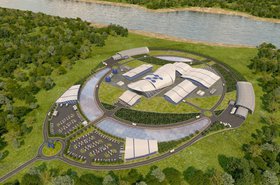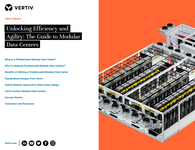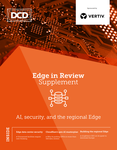With all the madness generative AI has caused in the data center world, it seems like 2023 flew by faster than Bard can respond to a prompt. As the gears of technology churn ever faster, it’s easy to feel like you’re on a hamster wheel, or maybe a Peloton, forever scrambling to keep up. 2023 brought us record data center leasing and talk of gigawatt-sized campuses. Remember when a 100-megawatt campus was considered big? With 2023 in the rearview mirror, it’s time to look back and grade my data-driven divinations and see how I performed.
A data center or cloud operator will sign up for nuclear power - Grade: A
As I wrote in my predictions a year ago, this was my most aspirational prediction. My thinking at the time was that hyperscale tech companies have been leading the world in the purchase of clean energy, so why wouldn’t they consider carbon-free nuclear energy? It turns out that I was right on that front as evidenced by the revelation that Microsoft Cloud was hiring for a nuclear technology program manager role in September. Also interesting was that Microsoft was training generative AI to handle the Small Modular Reactor (SMR) nuclear regulatory process. On the negative side, the much-publicized NuScale SMR project in Idaho was canceled under a cloud of suspicion.
In my prediction, I even hinted that it would be a great fit for a 2,000-acre data center campus in Maryland being billed as a first-of-its-kind environmentally friendly data center campus (aka Quantum Loophole). I don’t have any thoughts about whether the data center operators themselves will be operating these SMRs. The prevailing scenario is that they will enter into power purchase agreements (PPAs) like how renewables are purchased today.
I was a bit nervous about this prediction because information about these developmental projects tends to be very closely guarded. Through a contact in the nuclear industry, I found that one micro-nuclear power plant developer announced securing PPAs for several projects in Europe back in March. So, I hit this one early in the year and didn’t even know it! You must read the article carefully to find the data center aspect mentioned, but it’s in there. My prediction didn’t say where these projects would be located, so I’ll take the win on this one. I have several others that didn’t turn out as well, so I need this to keep my GPA up.
Generative AI tools like ChatGPT will threaten the educational system and anything else that requires writing - Grade: C
It’s hard to believe that ChatGPT was released just over a year ago on November 30, 2022. The impact generative AI has had on the data center market in such a short amount of time is like nothing the tech world has ever seen. That said, I think I overreacted with this prediction based on initial reports of using ChatGPT to write papers and replace other creative endeavors.
In coming up with my grade, I thought I would ask the chatbots themselves for their opinions. I started with Bard in hopes that it would throw its competitor under the bus and give me a good grade. Bard listed cheating, damage to critical thinking skills, degradation of the quality of content, and bias/ethical concerns as potentially harmful outcomes. Bard then listed personalized learning, language learning, accessibility, creativity, and critical engagement as potential benefits and opportunities.
ChatGPT gave a similar, but less robust, response listing both positive and negative outcomes. I have read of students and professionals both using generative AI to cheat or as a shortcut. Who can forget the case where a lawyer used ChatGPT to create a legal brief that included 6 fictitious case citations? I have also read of creative ways in which teachers are using generative AI to engage with their students. Another unforeseen outcome is that a new job category called Prompt Engineering has been created as a result of generative AI with over 1,500 job postings on LinkedIn as of this writing. So, as with any tech, it can be used for both good and bad, so I went with a simple C for a grade.
Big tech layoffs will increase the need for contingent workers/staff augmentation - Grade: B
When I wrote this prediction, I was working for a construction management/owner’s representative firm serving some of the big tech companies. Many of the big tech firms had gone through multiple rounds of layoffs, so my thinking was that those tasks and duties did not go away, which should give rise to a need for more contingent workers. In my research to grade this one, it turns out that I was not alone in this thinking. Eightfold AI projected a global increase in contingent workforce participation of 53 percent and an increase of 26 percent in the US. In August, a survey was released saying that 65 percent of companies worldwide planned to increase their reliance on contingent workers.
All this tells me is that others have the same thought, but where’s the data showing what actually happened in 2023? Maybe it’s too early for reports to be released with the data, because I have done search after search and can’t find anything. So, I asked my friend Bard to weigh in on it.
Bard said: “It's still too early to definitively say whether your prediction about tech layoffs leading to an increased need for contingent workers and staff augmentation in 2023 was entirely accurate. While there is evidence to support your claim, we're still in the early stages of observing the full impact of the layoffs.”
Bard also provided the following points:
- Significant tech layoffs: As you mentioned, 2023 saw a series of major layoffs in the tech industry. This undoubtedly created a larger pool of available tech talent in the contingent workforce.
- Increased demand for contingent workers: Some staffing agencies and industry experts reported a rise in demand for temporary and contracted tech workers in certain areas following the layoffs. This suggests that companies were seeking to fill staffing gaps without committing to full-time hires.
- Growth of staff augmentation services: There's anecdotal evidence and industry reports suggesting an increase in interest in staff augmentation services.
- The increase in contingent worker demand might not be sustained, or it might be concentrated in specific sectors or locations.
Bard’s initial statement prevents me from giving myself an A, but I think the talking points are enough to give me a solid B.
Use of data in construction expands and yields new insights - Grade: B+
Similar to #3, success is tough to quantify. Construction is the only non-farm industry that has not improved its labor productivity in almost 60 years, so it was my hope that the use of data would change this in 2023. I haven’t been able to find any reports that specifically track the use of data in construction, maybe I should have included technology in the prediction rather than data as the exponential growth in data often depends on technology to harness the transformative benefits. In any case, I dug deeper and gained some interesting insights.
I found numerous articles indicating that contractors are making wide use of AI and gaining value from doing so. AI is being used for wide-ranging tasks such as employee conflict resolution, hiring conversations, creating draft marketing materials, schedule optimization, and progress tracking. AI uses data to draw conclusions and create insights, so this is a step in the right direction.
There has been a massive increase in investment in construction tech startups to overcome a shortage of skilled labor. An estimated $50 billion was invested in architecture, engineering, and construction (AEC) tech between 2020 and 2022, 85 percent higher than the previous three years. Much of this investment has been focused on data analytics, including project management platforms and data visualization tools.
Evidence of increased data use in construction also includes the growing awareness of its benefits from improving project efficiency and reducing costs to optimizing resource allocation and enhancing safety. Other data-driven applications gaining traction include predictive maintenance, site logistics optimization, and sustainability analysis. A survey by McKinsey & Company found that 70 percent of construction executives believe that data and analytics will be transformative for the industry over the next five years.
Lest I paint too rosy of a picture, there are headwinds hindering widespread adoption of the expanded use of data. The construction industry is notoriously fragmented, with many small and medium-sized businesses that lack the resources or expertise to invest in data infrastructure and analytics. Construction projects generate large amounts of data from various sources, but ensuring data quality and effective integration across different platforms remains a challenge. There is a shortage of skilled professionals in the construction industry with the necessary data analysis and interpretation skills to make effective use of the data.
Much progress was made in 2023, so I gave myself a B+, but there is still much to do to realize the full benefits of data analytics in construction.
5G fails to live up to the hype…again - Grade: A+
This prediction was about closure for me. As I pointed out in my original prediction last year, I am a glutton for punishment as I started making predictions about 5G and how it would change the world all the way back in 2019. I wanted to prove to myself that I could stop beating my head against the wall on 5G!
I finally predicted that 5G would fail to live up to the hype again, and that it probably never would. I was finally right too! In 2023, we got more of the same from 5G. As TechDirt put it, 5G was largely just hype by telecoms and hardware vendors eager to sell more gear and to justify high US mobile data prices. There was talk of ultrawide-band and other cute marketing ploys, but it was nothing more than a little speed bump.
I noticed in 2023 that people finally stopped talking about all the amazing things 5G was going to do also. Join me in accepting 5G for what it is and let’s hope for better when 6G eventually arrives.
Microsoft’s investment in ChatGPT creator OpenAI will make Bing relevant - Grade: C
At the time I wrote this prediction, ChatGPT had only been released a month and a half earlier and was the biggest buzzword in tech, and I love buzzwords. About that same time, Microsoft announced that it would add ChatGPT to Azure. Not long after, Microsoft confirmed that it was making a "multiyear, multibillion-dollar investment" in OpenAI. My thinking was that although they had only announced adding ChatGPT to Azure, it would only be a matter of time before they added it to their little-used Bing search engine, and I was right on that part.
Whether or not it made Bing relevant is open to debate. On the positive, there was an initial surge in interest and user engagement upon integration, there was an enhanced user experience, and it offered some unique features when combined with other Microsoft offerings. On the negative side, it doesn’t seem that the interest was sustained, their brand perception issues remained, and the 800 lb. search engine gorilla that is Google later integrated its own AI-powered features.
In grading myself, I contend that the integration of ChatGPT into Bing did make it relevant in the short term. I also think that relevancy waned over time, but overall has Bing in a better position than before, thus the mediocre grade.
Regulation strikes the data center industry - Grade: B
When I wrote this prediction, note that I didn’t specify a location. I like to give myself some flexibility when doing these things. Regulation can apply to many areas ranging from where you build your data center to the source of the power used in it. There were highly publicized goings on in northern Virginia where the PW Digital Gateway project was challenged, but county officials eventually voted in favor of the rezoning measure.
In December, the UK government proposed new data center security and resiliency regulations seeking feedback from operators. The European Commission published the European Energy Efficiency Directive in September requiring data centers larger than 500 kW to report their energy efficiency figures. Similar legislation was passed in Germany. Closer to home, the California Energy Commission adopted new energy efficiency standards for data centers. There are also ongoing federal policy discussions, as well as state-proposed regulations in Virginia, Colorado, and California.
Although there was substantial regulation that hit the data center industry in 2023, one can see that considerably more may be coming in 2024.
The Edge will usher in the golden age of prefabricated data centers - Grade: C
When I made this headline prediction, it seemed a bit fluffy, so I clarified that 2023 would be the year that the Edge would lead to greater innovation in, and the proliferation of, prefabricated data centers. There was certainly great innovation in prefabricated data centers in 2023. One example is Compass Quantum, which unveiled its new, more sustainable design in 2023. They created a much lighter module by using a hardened composite design that performs well from a ballistic standpoint while using a reduced greenhouse gas emitting manufacturing process.
Later in the year, Vertiv launched its wooden data center modules using mass timber to make the containers more sustainable. Both concepts have a lower carbon footprint than the equivalent versions using either concrete or steel. Where I think my prediction fell down is the Edge leading to the proliferation of prefabricated data centers. It seems to me that companies are still figuring out how the Edge can impact their business, so I don’t think the Edge market has grown large enough to really say it’s growing the prefabricated data center sector.
How did I do?
As usual, my grades were a bit of a mishmash, but at least I didn’t fail on any of them this year! I am always interested in hearing how you think I did with my predictions. Please give me a shout on LinkedIn or Twitter (I refuse to call it X) with your thoughts. Also, keep an eye out for my 2024 predictions in the next couple of weeks right here on Datacenter Dynamics.









